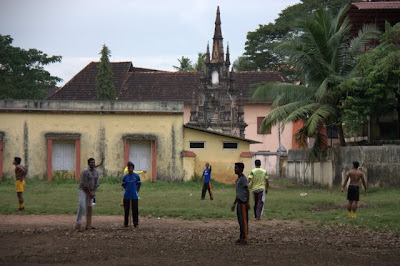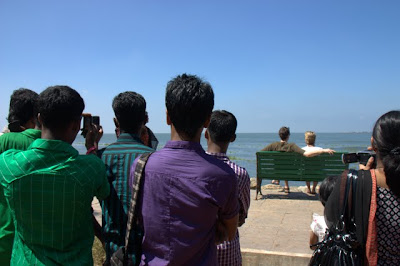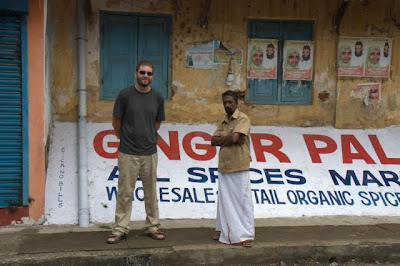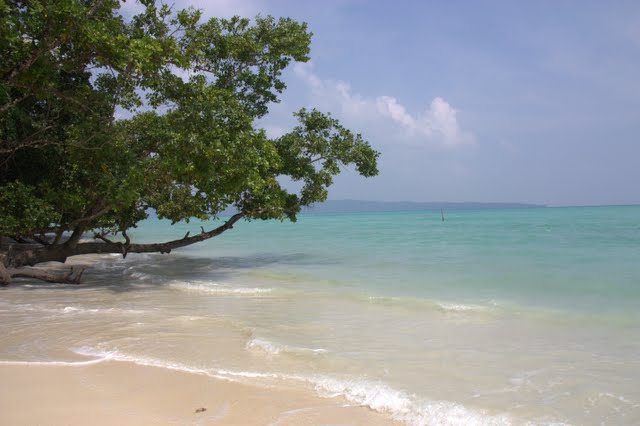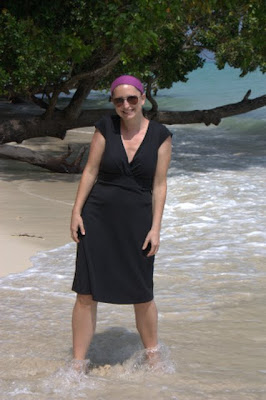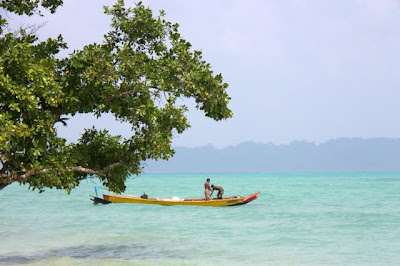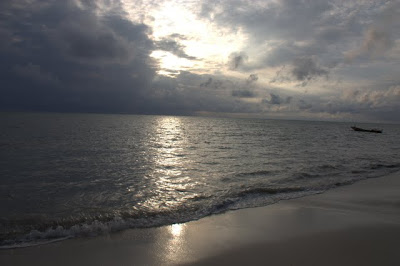India: The End.
As it turned out, the end to our Indian travels was rather anti-climatic. Other than a rickshaw driver taking us to a guesthouse run by his buddy rather than our intended destination (funny how he miraculously remembered English only when we threatened non-payment), nothing happened in Varkala, our last destination. And by nothing, I mean NOTHING. Once we found a sea facing hotel room with a balcony, that was the end of that.
It is no surprise that Varkala was uneventful. It barely felt like India. Walking along Varkala’s cliffside walkway, the only Indians you would see are the ones trying to get you to come into restaurants or shops. Our mornings started at any number of cafes playing Jack Johnson, serving banana pancakes and fruit shakes, and our evenings ended with a Kingfisher and some average Indian meals. Varkala was perfectly enjoyable, but it could have been anywhere.
Backwaters
And when I wake up in the morning to feel the daybreak on my face. There’s a blood that’s flowin’ through the feeling, with a knife to open up the sky’s veins. Some things will never change. They stand there looking backwards half unconscious from the pain. They may seem rearranged. In the backwater swirling, there is something that will never change.
– Backwater, Meat Puppets
Old black water, keep on rollin’
Mississippi moon, won’t you keep on shinin’ on me
Old black water, keep on rollin’
Mississippi moon, won’t you keep on shinin’ on me
Old black water, keep on rollin’
Mississippi moon, won’t you keep on shinin’ on me
Yeah, keep on shinin’ your light
Gonna make everything, pretty mama
Gonna make everything all right
And I ain’t got no worries
‘Cause I ain’t in no hurry at all
– Black Water, Doobie Brothers
The real jewel of God’s Country is undoubtedly Kerala’s backwaters. (Hence the busting out of an old 90s tune; the running soundtrack in my brain while we were in this part of Kerala was either this Meat Puppets song or Black Water. The waters weren’t black, but close enough.) Laying parallel to the Arabian Sea, the Keralan backwaters are a network of interconnected canals, rivers, lakes and inlets stretching for over 900 km. The canals are like roads; many people’s houses can only be accessed by boat and road signs give the distance to the next village. Similar to the Ganges, people who live along the backwaters very much live their lives in public, using the backwaters to bathe, wash dishes, and launder clothes. We did as many visitors to the backwaters do: rent an overnight houseboat to explore the labyrinth of canals and lakes. The houseboat comes with a two man boat crew, and you get three Keralean meals cooked aboard by one of the crew. Our experience on the backwaters was mixed: seeing life on the backwaters was fascinating, the scenery divine, but taking a tour by day probably would have accomplished the same thing for less money and maybe even allowed us to have seen more side canals. On the other hand, we did get to kick back and relax, and see the sun set over the backwaters. I took the picture above as we docked for the night next to one of the crew member’s canal side house.
Our biggest concern turned out to be our drinking water. When you read in the guidebook to always check to make sure your water bottles in India are sealed, do it. During negotiations for the boat ride, the owner promised us that the price included lots of bottles of water for us to drink. After getting out on the backwaters, Sean asked the crew for some water. One of them took a water bottle from the cooler, opened it, and handed it to Sean. After we finished the first bottle, we asked for a second one. This time, I happened to open the bottle myself, and noticed the cap wasn’t attached. I asked the other crew member for a different bottle. The new bottle also had a cap that wasn’t attached, and I inquired him why. Eventually, through a conversation in halting English, we established that all of the bottles weren’t factory sealed, they refill bottles of water themselves, and Sean and I weren’t happy about this situation, especially since we unknowingly drank one bottle already. If there’s one thing you don’t want to do in India, it is to drink the water. It was never clear to us whether this was a practice directed by the owner or whether the crew did it themselves. It appeared that the owner gave the crew money to purchase food and supplies for the trip, and we suspected that the crew may have been refilling water bottles themselves to try to save a few rupees. As it turns out, the crew picked us up a case of factory-sealed drinking water (which may not have been much of an improvement, as it was some sketchy brand we hadn’t seen elsewhere called Pizza Water with tons of misspellings on the container), and we never got sick from drinking whatever type of water with which they had refilled the original bottles. It is this type of thing that frustrates you again and again in India. No one means any harm, but you can never let your guard down.
Memo to Perverts Re: Your Weird Google Searches
To Whom It May Concern:
I’m sorry to disappoint the person who came to this blog after searching for “naked Japanese women in a hot spring,” or more disturbingly, “naked students onsen,” but as you’ve probably figured out by now, Google is not yet quite as fine tuned as you and it someday hope it might be. Take it from the many disappointed people who have come to Surrounded by the Sound after searching for some variation of a European country + “nude beach.” And to the person who day after day keeps searching for “Tom and Jerry porn” – ew, just ew.
Thank you for your attention to this matter.
Sincerely,
Amy
Welcome to God’s Country
We’d heard time and time again that southern India is much more laid back than northern India. As we landed in the southern Indian state of Kerala, we were hesitant. Having just left the blissful Andaman Islands, we weren’t really in the mood to dive back into the madness we had experienced in the north.
We can’t speak for all of southern India, but take it from us, Kerala is definitely not the north. On the way to our guesthouse from the airport, we were very confused. Why was the cars driving in their own lanes? Why weren’t they cutting off other cars? And most importantly, why is no one honking?
The state of Kerala is actually the world’s only democratically elected communist government and is one of India’s most progressive states. We hear that its not all rosy in Kerala – many breadwinners have to live abroad in the UAE and send money home to their families in order to make ends meet – but Kerala has made great strides in things like improving health care, raising literacy rates, and reducing litter. Keralans are proud of their state and have deemed it to be “God’s Own Country.”
A higher power certainly has bestowed beauty and lush tropical greenness upon Kerala. Our first introduction to Kerala was in the town of Fort Cochin, which is in the running with Kolkata to be my favorite city in India. (Not counting the fabulous Andaman Islands, of course). Like Kolkata, you can tell that the British once made their presence known in Fort Cochin. The Dutch and Portuguese also made their mark. Fort Cochin has a big Christian presence, and it was there that I saw an Indian nun for the first (and only) time.
Once we eliminated the small problem of ants trying to take up residence in our backpacks, we kept adding days onto our stay in Fort Cochin. We kept finding reasons to dawdle: an adorable little teahouse with Indian teas and a respectable death by chocolate cake; movie shoots to try to work our way into as extras; tropical flowers to photograph; fresh Keralean pineapple; waterside boardwalks with headbutting goats, Chinese fishing nets, ancient sprawling trees, and 1 rupee scales that tell you about your weight loss; Sean’s new Indian friends George and Justin at the old-school internet cafe; a cooking class to learn more about Keralean cuisine; an aryvuedic massage (which actually turned out to be NOT a good idea, but more on that later); dinner at a trendy, modern cafe cooked by local women; simultaneous pickup cricket and soccer games to watch; fantastic, delicious prawns from the seafood market, cooked with ginger and garlic; rickshaws decorated like Ferraris; real chicken briyani, finally; and tours by a guide named Magic Johnson. (And yes, I know there’s a lot of food on that list – we had some of our best meals in India in Fort Cochin).
Fort Cochin was enchanting, and we could have stayed longer, but the backwaters and beaches in God’s country were calling…
The one in which you will hate us if you are reading this from work or from a cold locale…
To say we were in India for 31 days almost feels like we were cheating, because 13 of those days were on the Andaman and Nicobar Islands. Set in the Bay of Bengal between India and Thailand, the islands are technically part of India, but their remoteness makes them something unique. The islands are actually geographically closer to Burma/Mynamar and Thailand than they are to India, but as of now, they can only be reached from India’s mainland. Because of their relative inaccessibility, development on the islands has been slow. Most of the tourists on the Andamans are upper-class Indians. Foreign tourists and most local tourists are not allowed to enter the Nicobar Islands, where ethnic tribes have been living their lives undisturbed for hundreds of years. Luckily for us, tourists are allowed , with a permit, onto the Andaman Islands. Other than a brief stint in Port Blair, the port of entry, we stayed at the Emerald Gecko on Havelock Island in a hut that was $15 a night. Beach No. 5, above, was a few feet from our doorstep. The Andamans are best seen, not described, so here’s some photos to either get you throwing darts at our pictures or, better yet, encouraging you to put New Year’s travel resolutions into action:
Port Blair:
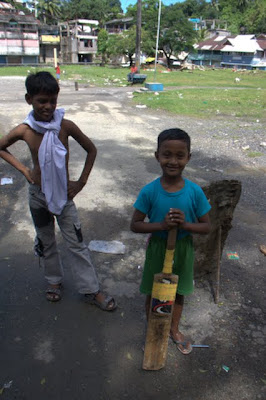
To reach the islands, all visitors must fly onto the main island at Port Blair. Contrary to what Lonely Planet may try to tell you, Port Blair is a get in and get out type of place. It's not what you've came all this way to see, but you at least have to spend the night on your way out of the Andamans. We spent most of our time on Port Blair making use of the glacially slow internet, but we wandered around a bit. We came across these kids playing cricket in an empty lot, who paused their game to eagerly jump in front of the camera.

While the food on Havelock Island (and particularly at the Emerald Gecko) was some of the best we've had on our trip, the food in Port Blair leaves a lot to be desired. I ordered naan, an Indian bread, and it was served to me like this: wrapped in a dish towel that looked like it was used to clean up the kitchen for the post month. To add insult to injury, the waiter kept urging me to eat it, and even went as far as to unwrap it and touch the naan, saying, "why don't you eat the naan? It is hot, see? You must eat it when it is hot." I developed a sudden bread allergy...
Beach No. 5, Havelock Island

Upon our arrival on Havelock, we promptly took naps in these hammocks, listening to the waves. Sean thus achieved a goal he first had formulated when sitting in his cube. We could often be found here during our 10 days on the island. We nicknamed another couple the Hammock Hogs because they were often occupying the hammocks when we wanted to use them, but given the amount of time we spent there, I think the nickname was more appropriate for us.
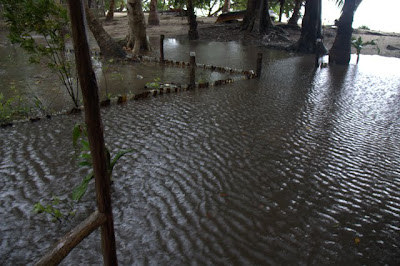
The flip side to the lushness of paradise is that it must rain. We accidentally went to the Andamans during monsoon season, which meant we were subjected to two days of torrential downpours. The rains flooded the grounds of Emerald Gecko. This was the view from our hut during the rains.
The Infamous Beach No. 7

If you spend any amount of time on Havelock, you will soon hear about the lure of Beach No. 7, located way on the other side of the island. All of Havelock's beaches have white sand and waters that are different shades of blue and green, but none of the beaches have sand as soft as or waters that are as clear and easy to swim in as Beach No. 7.
Around the rest of Havelock Island

When we weren't napping in hammocks or lounging on beaches, you might find us scooting around the island on the scooter we rented for $4 a day.

Sean at Anju Coco, a shacklike restaurant we frequented when we weren't scarfing down the delicious food at Emerald Gecko. Despite eating banana pancakes for 10 days straight, I never got a photo.

One of our favorite days on the island was when we took the scooter past Beach No. 5 away from Village No. 1. There is a small, but developing tourist strip from Beach No. 3 to Beach No. 5, but beyond, there was not a tourist in sight. (Yes, everything is known by numbers, not names).

It is not hard to find fantastic deserted beaches around the island, especially if you head past Beach No. 5 away from the boat jetty in Village No. 1.













